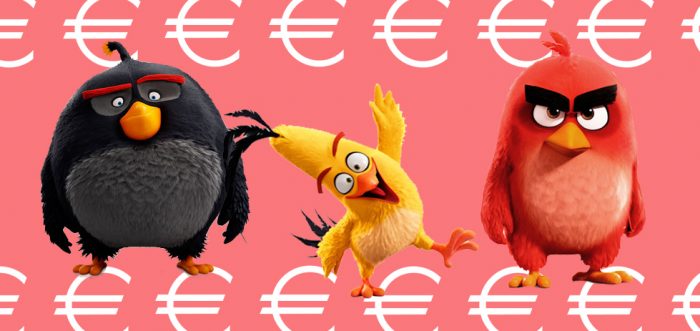There’s really no other way to say it; Angry Birds: The Movie is absurdly expensive. Depending on where the value of the Euro is sitting and the reliability of other expenditure estimates it could potentially slide into being one of the 50 most expensive movies of all time (unadjusted for inflation). Rovio Entertainment, who created the original iOS game, has fronted around €80 million to finance the film, splitting the €100 million extra advertising cost with distributer Sony. Rovio’s final figure is not disclosed at this point but it is confirmed they have put in at least €100 million.1
Of course a lot of money is sunk into feature-length toy commercials all the time but the story of Rovio and Angry Birds is bizarre. For one thing Rovio is a Finnish tech company and producing the film themselves, making this easily the most expensive Finnish film ever made, outstripping the previous record holder ten times over. As the first mainstream cinematic adaptation of a mobile game it’s a pretty big sum but even when compared to live action blockbuster adaptation of Triple AAA console series that have been going for decades it’s huge. For comparison’s sake the latest Resident Evil film was made on $65 million, Need For Speed only cost $1 million more. To find something in the Angry Birds level of confidence you need to turn to the A-list studded tentpole productions of Tomb Raider and Prince of Persia, the latter of which was a complete bomb.2
If the video game comparison doesn’t match up then maybe it’s best to compare this project to toy adaptations, a trend Hollywood has begun to latch onto to the increasing derision and dismay of critics and audiences. Even when counting the big budget action films, Angry Birds is still ahead of the first Transformers and G.I. Joe films (once again unadjusted for inflation) while only lagging behind Battleship’s hilariously confident $220 million, which famously proved to be poor judgment on everyone’s part. The obvious best case scenario for adapting these kind of properties is The Lego Movie, winning a lot of critical acclaim and almost half a billion at the box office. It’s budget? A mere $60 million, and this is an adaptation of one of the most iconic and beloved toy franchises in history as opposed to a nine-year old mobile time-waster about suicidal birds attacking biologically incorrect green pigs. And leaving aside the ludicrous notion that Angry Birds inspires more confidence and money than Lego, all these films were simply licensing rights handed to actual production studios who had been doing this sort of things for years. What kind of company creates it’s own studio out of nothing to exclusively adapt it’s own properties into top-tier productions?
Rovio got the same answer that you did; Marvel and without missing a groan-worthy predictable beat they went and hired David Maisel. Maisel was one of the key players in creating the Marvel Studios powerhouse, securing the funding from Merryl Lynch, wresting control from previous supreme producer Avi Arad to create the first slate of films that led to The Avengers and ultimately setting up the Disney acquisition before leaving the company. If you’re a self-contained production upstart that’s adapting its own properties you’d obviously try and borrow some of that sweet sweet Marvel methodology. What should be the painfully obvious difference is that Marvel had been a recognizable brand for over fifty years, having provided the rights to some of the most profitable films of all time and had a huge slate of characters that ranged from beloved cult figures (Guardians of the Galaxy) to cultural icons (Captain America). To reiterate Rovio really only have Angry Birds, to the extent that the few (not particularly successful) games they have made that aren’t Angry Birds spin-offs are now made by a subsidiary, and that their ‘beloved’ property has only been around for six years.
But Rovio’s perversely autonomous approach has been going on for a while now. They bought their own animation studio to create a series of cartoons of a diverse nature such as Angry Birds Toons, Piggy Tales and Angry Birds Stella. Not content to stop there they went ahead and created their own distribution channel, Toons.TV, an app with a surprising amount of hardware support (more than most Australian streaming services for one thing). Even Disney haven’t gone that far yet. If all this sounds like a misguided and borderline-deluded approach it’s because it is. Rovio’s profits decreased by 73% in 2014 after laying off 110 employees.
Rovio’s ambitions, particularly in regards to the upcoming film, must be about more than making money. If you wanted to market apps and toys you don’t need to spend $185 million dollars. In its best case scenario (i.e. success on par or superior to The Lego Movie) it would still be hard to justify the huge expenditure even if the film bolsters app sales, which in turn would bolster toy sales which would feed into the movie and so on. If Rovio’s strategy does work, and so far it doesn’t look like it will, it would be hard not to argue that the relatively young company could have had the better result by simply licensing or outsourcing its own properties.
There’s a lot of talk about how Marvel’s ‘cinematic universe’ approach is being poorly mimicked by other studios, much to their detriment. But this is a rare case of a far less powerful, iconic or profitable company trying to imitate their uniquely successful in-house approach. Like watching a child break their legs while trying to fly like Iron Man, Rovio’s hubristic attempt to mimic Marvel by hiring Maisel is both a little stupid and a little sad. New Rovio chief executive Pekka Rantala says “you can say a lot of things about us, but you surely can’t accuse us of a lack of courage.” The same could be said of his beloved kamikaze birds – either way they don’t come back.
